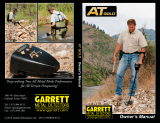
7
Pinpoinng:
Pinpoinng means to determine the posion of the found object as exactly as
possible. There are detectors with a built-in pinpoinng feature and also external
pinpointers. You can use your detector‘s pinpoinng feature to locate the target
more accurately, so it‘s enough to dig a small hole. With a loose pinpointer you
can nd the object inside the hole faster.
Discriminaon:
Depending on how conducve the metal your detector nd is, it will show a me-
tal ID number from 1 to 99. Via discriminaon you can for example let the detec-
tor ignore all objects that score 1 to 40 to avoid nding lots of nails or other iron
objects.
Notch:
The notch feature is very similiar to discriminaon, but is more exible. You can
pick a certain metal ID-segment and let the detector ignore objects in that seg-
ment or, opposingly, only search for objects in that segment.
4. Explanaon of terms
Ground balancing:
In the ground there are several small minerals with metals aached to them. To
prevent that your detector permanently reacts to those minerals, it can perform
ground balancing. The detector lters the magnec eld of the ground and is able
to ignore it. With a Ground Tracking feature the detector is able to automacally
adjust its ltraon of the mineralizaon in the respecve ground.
Sensivity:
Sensivity and depth seng go hand in hand. The higher the sensivity is set on
your detector, the deeper it searches and the more sensive it becomes in terms
of ground disturbances and electromagnec interferences. The lower the sensi-
vity, the less disturbances you will experience, at the expense of your depth per-
formance.
Frequency:
The frequency of the detector determines how many electronic waves it sends
into the ground per second. If the frequency is low, you are able to nd bigger
targets deeper in the ground. If it‘s high, the detector will recognize smaller ob-
jects nearer to the surface. With some detectors, like the Quest Q60, you are
able to switch between mulple frequencies.






















